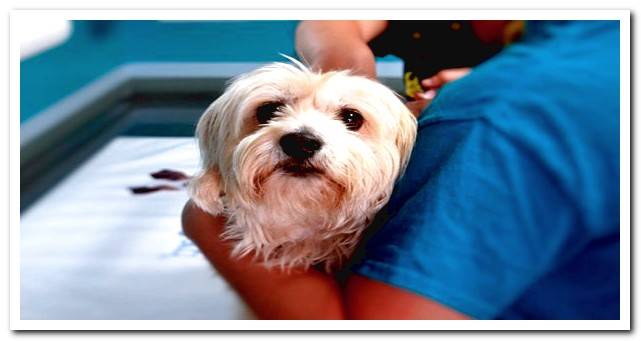
Among the cutaneous pathologies that dogs can suffer, there is a group of rare autoimmune diseases, which are known as canine pemphigus complex.
These skin diseases are characterized in that the animal develops a series of lesions in the mucosa or skin (vesicles, ulcers and crusts), which can be very painful for the animal. Let’s see in detail everything related to this pathology.
Index of contents
- 1 What is canine pemphigus?
- 2 What causes cause pemphigus in dogs?
- 2.1 Symptoms produced by pemphigus vulgaris in dogs
- 2.2 Pemphigus foliaceus symptoms
- 2.3 Symptoms produced by paraneoplastic pemphigus
- 2.4 Symptoms of pemphigus erythematosus
- 3 Which races are more predisposed to suffer pemphigus?
- 4 How is pemphigus diagnosed?
- 5 Treatment for pemphigus
- 5.1 Pemphigus Dogs Prognosis
What is canine pemphigus?
The canine pemphigus complex encompasses a group of autoimmune skin diseases, which are characterized by loss of cohesion between skin cells.
What happens in dogs with this disease is that their own body generates autoantibodies, which attack certain components of the skin, causing significant skin changes. Specifically, autoantibodies (IgG) are formed against the components that hold epidermal cells together.
Four types of pemphigus have been described in dogs: foliaceous pemphigus, pemphigus vulgaris, erythematous pemphigus, and paraneoplastic pemphigus. Pemphigus foliaceus is the most common form of presentation in dogs.
What causes cause pemphigus in dogs?
Dogs can suffer pemphigus spontaneously, however, this pathology can also be associated with certain factors:
- The foliaceous pemphigus it can start with the administration of certain drugs. If the disease resolves when the drug is withdrawn, it is called a “pemphigus foliaceus-type drug reaction,” and if the disease persists after drug withdrawal, it is called a “drug-induced foliaceous pemphigus.” In the dog, the drugs that cause these reactions are usually trimethoprim-sulfamide antibiotics.
- Paraneoplastic pemphigus It is associated with neoplastic diseases.

Symptoms produced by pemphigus vulgaris in dogs
Pemphigus vulgaris is characterized by the formation of vesicles on the mucosa and on the skin, which rupture and ulcerate rapidly. Most cases begin with the appearance of ulcers at the mucocutaneous junctions and oral cavity. If skin lesions appear, they are located mainly in the armpit and English areas, and in the nasal plane (on the muzzle).
This type of pemphigus is accompanied by systemic signs such as fever, depression and loss of appetite.
Pemphigus foliaceus symptoms
Pemphigus foliaceus is a disease whose symptoms appear progressively, giving rise to formation of vesicles or pustules, redness of the skin, peeling, hair loss and evident appearance of crusts. These lesions normally begin in the dorsal part of the muzzle, face and ears, and then slowly generalize. The foot pads can be affected, showing redness and hyperkeratosis.
Rarely, these lesions are accompanied by systemic symptoms, although there may be variable itching. Unlike pemphigus vulgaris, it usually only affects the skin, with the appearance of lesions at the mucocutaneous junctions or in the oral cavity being rare.
Symptoms produced by paraneoplastic pemphigus
Canine paraneoplastic pemphigus is a rare disease associated with neoplastic diseases. It is characterized by the formation of blisters, located mainly in the mucosa and cutaneous junctions. It is usually accompanied by fever and depression.
Symptoms of pemphigus erythematosus
The lesions that accompany the erythematous pemphigus consist of pustules that develop into ulcers, erosions and crusts. Depigmentation areas can also be seen. These lesions are located on the face, mainly in the nose and in the pinnae.
Which races are more predisposed to suffer pemphigus?
For pemphigus vulgaris there is no racial, age or sexual predisposition. However, the Collie, the Akita, the Chow Chow, the Newfoundland, the Shipperke, the Doberman Pinscher, the English Springer Spaniel and the Shar pei, are the breeds most predisposed to suffer from foliaceous pemphigus. Furthermore, some studies suggest a high incidence of pemphigus foliaceus in allergic dogs.
How is pemphigus diagnosed?
The symptoms described suggest by themselves the possible existence of an immunomediated disease, but there are other pathologies that can give similar clinical signs:
- Systemic lupus erythematosus, drug eruptions, skin neoplasia, mucocutaneous candidiasis, are some of the pathologies with symptoms similar to those described for pemphigus vulgaris and paraneoplastic.
- Demodicosis, superficial pyoderma, dermatophytosis, discoid lupus erythematosus, rash due to drugs, are some of the processes that have clinical signs similar to those that occur in pemphigus foliaceus and erythematosus.
Therefore, in order to diagnose canine pemphigus, it is necessary to perform a histopathological examination of a sample for biopsy, in addition to clinical examination. In some cases, more specific analyzes are required (immunohistochemistry).

Treatment for pemphigus
Treatment of canine pemphigus is aimed at suppressing clinical signs as soon as possible and maintaining this clinical remission over time. Being an immune-mediated disease, its treatment is based on the administration of immunosuppressive drugs (prednisolone or methylprednisolone, among others).
These drugs can have side effects, especially on the digestive system, which is why the administration of intestinal protectors is necessary (sucralfate or omeprazole)
, and a thorough veterinary monitoring of the animals under treatment should be carried out to detect possible adverse effects.
If an improvement in one or two weeks is not observed with this treatment, other immunosuppressive agents should be added (aziatropine, chlorambucil, cyclophosphamide or sulfasalazine, among others).
During the initial stages of treatment, antibiotics are recommended, as recent studies suggest that this regimen significantly improves symptom remission and long-term survival.
When the medication achieves a remission of the symptoms, the veterinaryn should gradually reduce the dose of the immunosuppressive drugs until reaching the minimum dose necessary to keep the symptoms under control (maintenance dose).
Pemphigus Dogs Prognosis
The prognosis of dogs with pemphigus is reserved, especially for those with pemphigus vulgaris. Pemphigus vulgaris usually has an unfavorable prognosis since, in some cases, treatment does not achieve an acceptable level of remission of symptoms so that the animal can have a good quality of life or the treatment causes unacceptable side effects.
